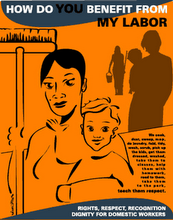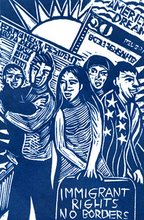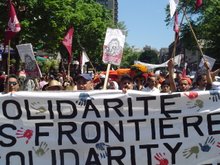Tamara K. Nopper
April 17, 2007
Like many, I was glued to the television news yesterday, keeping updatedabout the horrific shootings at Virginia Tech University. I was tryingto deal with my own disgust and sadness, especially since myprofessional life as a graduate student and college instructor is tiedto universities. And then the other shoe dropped. I found out from afriend that the news channel she was watching had reported the shooteras Asian. It has now been reported, after much confusion, that theshooter is Cho Seung-Hui, a South Korean immigrant and Virginia Techstudent.
As an Asian American woman, I am keenly aware that Asians are about tobecome a popular media topic if not the victims of physical backlash.Rarely have we gotten as much attention in the past ten years, except,perhaps, during the 1992 Los Angeles Riots. Since then Asians areseldom seen in the media except when one of us wins a golfing match,Woody Allen has sex, or Angelina Jolie adopts a kid.
I am not looking forward to the onslaught of media attention. Ifhistory truly does have clues about what will come, there may be severaldifferent ways we as Asian Americans will be talked about.
One, we will watch white media pundits and perhaps even sociologistsexplain what they understand as an "Asian" way of being. They will talkabout how Asian males presumably have fragile "egos" and therefore areculturally prone to engage in kamikaze style violence. These statementswill be embedded with racist tropes about Japanese military fightersduring WWII or the Viet Cong—the crazy, calculating, and hidden Asianman who will fight to the death over presumably nothing.
In the process, the white media might actually ask Asian Americans ourperspectives for a change. We will probably be expected to apologize insome way for the behavior of another Asian—something whites never haveto collectively do when one of theirs engages in (mass) violence, whichis often. And then some of us might succumb to the Orientalist logic ofthe media by eagerly promoting Asian Americans as real Americans andtherefore unlike Asians overseas who presumably engage in culturallyreprehensible behavior. In other words, if we get to talk at all, AsianAmericans will be expected to interpret, explain, and distancethemselves from other Asians just to get airtime.
Or perhaps the media will take the color-blind approach instead of astrictly eugenic one. The media might try to whitewash the situationand treat Cho as just another alienated middle-class suburban kid. Insome ways this is already happening—hence the constant referrals tothe proximity of the shootings to the 8th anniversary of the Columbinekillings. The media will repeat over and over words from a letter thatCho left behind speaking of "rich kids," and "deceitful charlatans."They will ask what’s going on in middle-class communities that encouragethis type of violence. In the process they may never talk about thedirty little secret about middle-class assimilation: for non-whites, itdoes not always prevent racial alienation, rage, or depression. Thismay be surprising given that we are bombarded with constant imagessuggesting that racial harmony will exist once we are all middle-class.But for many of us who have achieved middle-class life, even if we maynot openly admit it, alienation does not stop if you are not white.
But the white media, being as tricky as it is, may probably talk aboutCho in ways that reflect a combination of both traditional eugenic andcolorblind approaches. They will emphasize Cho’s ethnicity and economicbackground by wondering what would set off a hard-working, quiet, SouthKorean immigrant from a middle-class dry-cleaner-owning family. Theywill wonder why Cho would commit such acts of violence, which we expectfrom Middle Easterners and Muslims and those crazy Asians from overseas,but not from hard-working South Korean immigrants. They will promoteCho as "the model minority" who suddenly, for no reason, went crazy.Whereas eugenic approaches depicting Asians as crazy kamikazes or VietCong mercenaries emphasize Asian violence, the eugenic aspect of themodel minority myth suggests that there is something about AsianAmericans that makes them less prone to expressions of anger, rage,violence, or criminality. Indeed, we are not even seen as havinglegitimate reasons to have anger, let alone rage, hence the need tofigure out what made this "quiet" student "snap."
Given that the model minority myth is a white racist invention thatelevates Asians over minority groups, Cho will be dissected as ananomaly among South Koreans who "are not prone" to violence - unlikeBlacks who are racistly viewed as inherently violent or South Asians,Middle Easterners and Muslims who are viewed as potential terrorists.He will be talked about as acting "out of character" from the other"good South Koreans" who come here and quietly and dutifully worktowards the American dream. Operating behind the scenes of course is adiplomatic relationship between the US and South Korea forged throughbombs and military zones during the Korean War and expressed through thenew free trade agreement negotiations between the countries. Indeed,even as South Korean diplomats express concern about racial backlashagainst Asians, they are quick to disown Cho in order to maintain theimage of the respectable South Korean.
Whatever happens, Cho will become whoever the white media wants him tobe and for whatever political platform it and legislators want to push.In the process, Asian Americans will, like other non-whites, be pickedapart, dissected, and theorized by whites. As such, this is nodifferent than any other day for Asian Americans. Only this time anAsian face will be on every television screen, internet search engine,and newspaper.
Tamara K. Nopper is an educator, writer, and activist living in Philadelphia. She can be reached at tnopper@yahoo.com.















